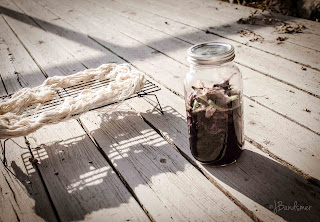Anyway, I figured it was time to just do it. So:
Ordered a pound of alum powder from the pharmacy. Since it's far cheaper than getting it from the grocery store.
Pleasantly requested that my aunt freeze her dark purple iris flowers from me when they were about done. Which she did this summer.
Bought some gigantic 1.9 litre canning jars - Bernardin... "Because You Can." (Ha ha. Best tagline ever.)
Steps:
1. Weigh out alum powder: weigh the silk and divide by four. In my case, 104 g silk... 26 g alum powder.
2. Dissolve alum in hottish water. Stuff skein in, squeezing out air from yarn (you should really use gloves; the picture betrays that I didn't follow my own advice). Let sit in the hot sun for an hour or two. Alternately, you can simmer this mixture on your stove. (If you are using wool, be careful to change water temperatures slowly, as you can felt your wool! And always simmer, never bring to a fast boil.) Use enamel pot dedicated to dyeing if you are using the stove or a hotplate, if you can.
3. Let silk skein dry. The mordant (alum) will then be bound to the yarn.
4. Meanwhile, measure out your irises, pour hot water into the jar along with the irises, and put out in the sun to start the dye extraction. The dark purple irises supposedly give a lovely green color (irises have been used to produce green ink for hundreds of years or more). Apparently you can also dye with other colors of irises, although in this case it is suggested to use the entire plant, not just the flowers. I admit I hoped that somehow I could get the beautiful purple irises to produce make a purplish dye, even though everything I had read suggested otherwise (after all, no one had done solar dyeing!)
I decided to use all the irises (354 g of frozen iris). There seemed to be a lot of color still left in the dye water afterwards, so I froze it to potentially use again.
5. Once the yarn is dry, stuff it into the jar with the irises, top with water, and put out in the sun. I left the yarn in the sun for about a week, bringing it inside in the evening and popping it under some warm lights for the night.
6. Remove the yarn from the dye mix (using gloves!), squeeze gently to remove excess liquid. Air dry. I decided not to leave it in the sunshine, as UV radiation will leach the color out of anything. I had this stunningly beautiful silvery-purple skein of silk! But I knew I still had to rinse it...7. Rinse the skein until no color comes out. Unfortunately for my hopes, the purplish color is what remains soluble, so that comes out rather quickly. However, the greenish color that remains is beautifully complex - minty green with purplish blue overtones. My work colleagues all told me how beautiful the color was. And then they were surprised to hear that I had dyed it myself!
8. Make something with the yarn! Or sell it. At least do something with it. My plan all along was to make my aunt, the grower of the lovely irises, a silk scarf. I hope she likes it.
In explanation as to why there are now three skeins - one of them dyed yellow... I decided to use the sunshine and the marigolds from the front yard to dye the last skein of silk that I had. The process was the same for me, except that I used the leftover "alum water" from soaking the first skein to also soak the second skein. This is less scientific, but a good use of resources and less polluting, as there is certainly alum left in the water after the first soak. The marigold color is a lovely golden yellow, although the "gold" part of it seems to be missing from the above photo; the colors below are more accurate.












You've inspired me! Thank you for sharing exactly what I wondered about my iris plants. I grow Siberian, bearded, and classic iris, so I do a lot of dead-heading each year. I love the idea of freezing the flowers until it's convenient for me. You've really thought through every step. Now I'll have a tangible memory of the blooms besides the occasional photo.
ReplyDeleteKaren
This is great! Thanks! I noticed my irises always have this incredible blueish-black juice as they decompose and I always thought to use it somehow. I wonder what would happen if iron was added to the mix.
ReplyDeletei am trying this today. thanks so much. i have had some irises in the freezer for about two weeks. i have some small pieces of linen pre-mordanting in iron water & separately in alum using you solar method. As well my irises are out there in the Aussie sun in a ziplock bag for a couple of hours. i'm excited to see what happens next
ReplyDelete